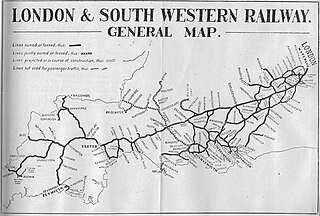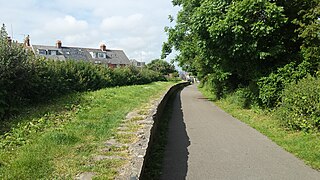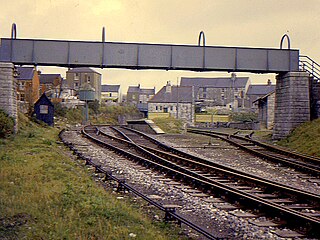
The London and South Western Railway was a railway company in England from 1838 to 1922. Originating as the London and Southampton Railway, its network extended to Dorchester and Weymouth, to Salisbury, Exeter and Plymouth, and to Padstow, Ilfracombe and Bude. It developed a network of routes in Hampshire, Surrey and Berkshire, including Portsmouth and Reading.

Loughton is a London Underground station in the Epping Forest district of Essex. It is entirely above ground, and platforms are accessed by staircases which rise from ground level.

The Somerset and Dorset Joint Railway, also known as the S&D, SDJR or S&DJR, was an English railway line connecting Bath and Bournemouth, with a branch from Evercreech Junction to Burnham-on-Sea and Bridgwater. Strictly speaking, the main line ran from Bath Junction to Broadstone, as the line between Broadstone and Bournemouth was owned by the London and South Western Railway, while the line between Bath Junction and Bath was owned by the Midland Railway.

Hull Paragon Interchange is a transport interchange providing rail, bus and coach services located in the city centre of Kingston upon Hull, England. The G. T. Andrews-designed station was originally named Paragon Station, and together with the adjoining Station Hotel, it opened in 1847 as the new Hull terminus for the growing traffic of the York and North Midland (Y&NMR) leased to the Hull and Selby Railway (H&S). As well as trains to the west, the station was the terminus of the Y&NMR and H&S railway's Hull to Scarborough Line. From the 1860s the station also became the terminus of the Hull and Holderness and Hull and Hornsea railways.

Wareham railway station serves the historic market town of Wareham in Dorset, England. It is situated about 0.6 miles (1 km) north of the town centre. It is 120 miles 70 chains (194.5 km) down the line from London Waterloo. On tickets it is printed "Wareham Dorset" to avoid confusion with Ware railway station.

Ringwood is a closed railway station in the county of Hampshire, England which served the town of Ringwood. It lay on the former Southampton and Dorchester Railway, the original main line from a connection with the London and South Western Railway at Southampton through Brockenhurst to Dorchester.
There are 22 disused railway stations on the Bristol to Exeter line between Bristol Temple Meads and Exeter St Davids. The line was completed in 1844 at which time the temporary terminus at Beambridge was closed. The most recent closure was Tiverton Junction which was replaced by a new station} on a different site in 1986. 12 of the disused stations have structures that can still be seen from passing trains.

The Portland Branch railway refers to a group of lines on the Isle of Portland in the English county of Dorset. The first was the Portland Railway, a tramway with a counterbalanced rope-worked incline. It opened in 1826. It was followed by the Weymouth and Portland Railway, which connected to the main line of the Great Western Railway at Weymouth. It opened in 1865. From the late 1840s until 1872, Portland Breakwater was built, a prodigious construction task that created a very large safe harbour. It was decided to provide a railway connection to the breakwater, which was used as a pier for bunkering ships. This was constructed by the LSWR and the GWR jointly and opened in 1876. The fourth line was the Easton and Church Hope Railway. This line was conceived as a simple descent to bring stone down from quarries to a new jetty at Church Ope, but after their line was authorised in 1867, the Company delayed useful construction, and a change of plan followed, with several Acts of Parliament authorising modifications to the route and extension of time. It finally opened in 1900.
There are seventeen disused railway stations on the Cornish Main Line between Plymouth in Devon and Penzance in Cornwall, England. The remains of nine of these can be seen from passing trains. While a number of these were closed following the so-called "Beeching Axe" in the 1960s, many of them had been closed much earlier, the traffic for which they had been built failing to materialise.
There are eight disused railway stations between Wadebridge and Bodmin North on the former Bodmin and Wadebridge Railway in Cornwall, in the United Kingdom, with ten other closed sidings on the branches to Ruthern Bridge and Wenfordbridge. The section from Boscarne Junction to Bodmin General is currently part of the Bodmin and Wenford Steam Railway; the line from Wadebridge to Wenfordbridge is now part of the Camel Trail, and the line to Ruthern Bridge can be followed for much of its length as it runs parallel to a public road.

Verwood railway station served the town of Verwood, Dorset, England from 1866 to 1964.

Glastonbury and Street railway station was the biggest station on the original Somerset and Dorset Joint Railway main line from Highbridge to Evercreech Junction until closed in 1966 under the Beeching axe. It was the junction for the short branch line to Wells which closed in 1951.

Melcombe Regis was a station on the Portland Branch Railway in the English county of Dorset. Opened in April 1909, it was sited at the north end of the bridge over Radipole Lake. The station was built to enable Portland branch passengers to go to Weymouth without the need for the branch train to reverse to enter Weymouth railway station. The branch junction was to the north of Weymouth station and faced Dorchester. The station was closed officially, along with the branch, on 3 March 1952. However, the station continued to be used for overflow from the adjacent Weymouth station, particularly on summer Saturdays: regularly until 12 September 1959 and irregularly for a while after that.

Westham Halt was a small railway station in Westham on the Portland Branch Railway in the west of the English county of Dorset.

Rodwell was a small railway station on the Portland Branch Railway in the west of the English county of Dorset.

Easton railway station was the terminus of the Portland Branch Railway, which operated on the Isle of Portland in the south of the English county of Dorset.
The Mangotsfield and Bath branch line was a railway line opened by the Midland Railway Company in 1869 to connect Bath to its network at Mangotsfield, on its line between Bristol and Birmingham. It was usually referred to as "the Bath branch" of the Midland Railway.
Rosherville Halt was a railway station on the Gravesend West Line which was built to serve the popular Rosherville Gardens, a pleasure garden in Gravesend which closed in 1910. The station survived a further 23 years before itself closing in 1933.

The Helston Railway is a heritage railway in Cornwall which aims to rebuild and preserve as much as possible of the former GWR Helston Railway between Nancegollen and Water-Ma-Trout on the outskirts of Helston. It is operated by the Helston Railway Preservation Company using members of the Helston Railway Preservation Society.
The Yeovil–Taunton line was a railway line in England, built by the Bristol and Exeter Railway (B&ER) to connect its main line with the market town of Yeovil in Somerset. It opened in 1853 using the broad gauge of 7 ft 1⁄4 in and was the first railway to serve Yeovil. It ran from a junction at Durston although in later years passenger trains on the line ran through to and from Taunton where better main and branch line connections could be made.













